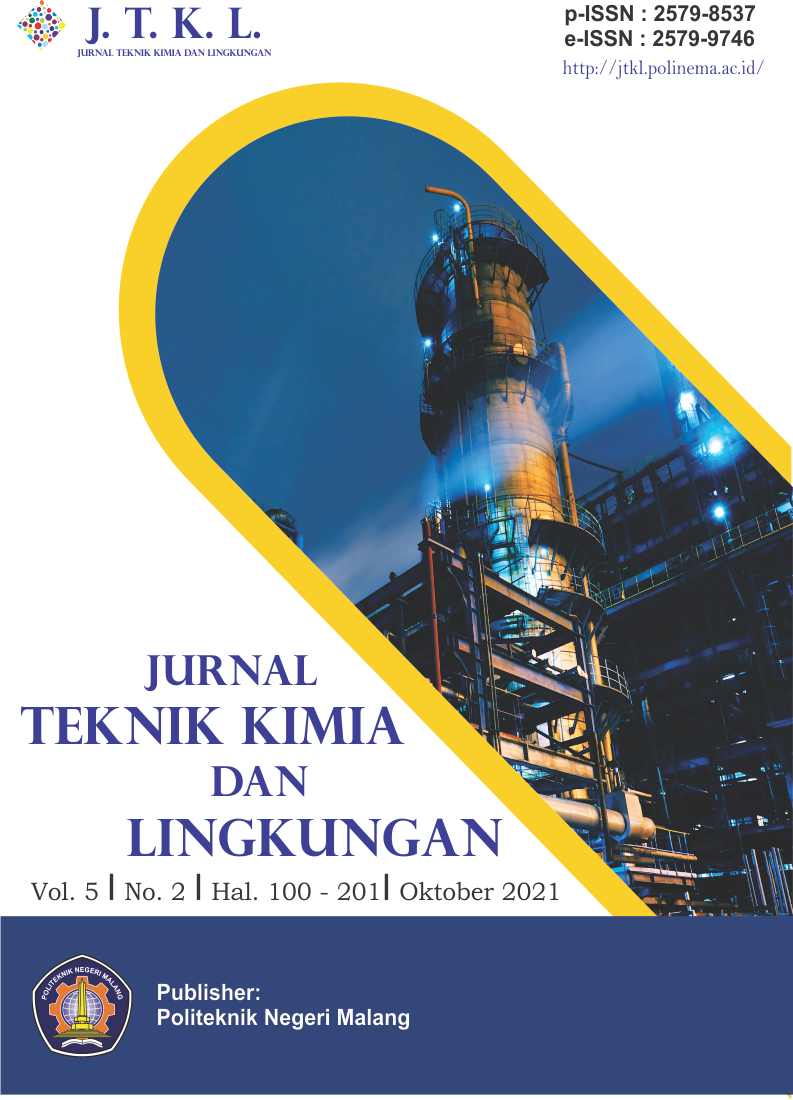Penyisihan Pencemar Air Limbah Industri Rumput Laut Menggunakan Nano Karbon Aktif
DOI:
https://doi.org/10.33795/jtkl.v5i2.252Keywords:
alkalis, organic matter, nano activated carbon, removal, seaweedAbstract
Air limbah yang dihasilkan oleh industri pengolahan rumput laut memiliki volume yang cukup besar dengan karakteristik pH: 11 13 (alkalis), BOD: 200-300 ppm, COD: 500-700 ppm sehingga kurang efisien jika diolah menggunakan proses biologi dan adsorpsi kimiawi. Penelitian bertujuan untuk menganalisa kemampuan nano karbon aktif mengadsorpsi bahan-bahan pencemar (pollutans) dalam suatu kolom adsorpsi alir kontinyu. Penelitian dilakukan dengan cara mengalirkan air limbah rumput laut ke dalam kolom adsorpsi yang berisi adsorben nano karbon aktif pada ukuran 1-25 nm. Variabel percobaan yang digunakan adalah tekanan operasi (2 dan 4 MPa), serta berat adsorben nano karbon aktif (50, 100 dan 150 g) dengan lama adsorpsi 1 jam. Hasil percobaan menunjukkan bahwa pada tekanan 4 MPa dan berat adsorpben nano karbon aktif 150 g dengan waktu adsorpsi selama 25 menit memberikan penyisihan BOD, COD dan TSS maksimal masing-masing sebesar 96,4; 96,4 dan 94,5%.
Wastewater produced by the seaweed processing industry has a large enough volume with the characteristics of pH: 11-13 (alkaline), BOD: 200-300 ppm, COD: 500-700 ppm so it is less efficient if treated using biological processes and chemical adsorption. The aim of this research is to analyze the ability of activated carbon nano to adsorb pollutants in a continuous flow adsorption column. The study was conducted by flowing wastewater seaweed into the adsorption column containing the adsorbent activated carbon nano in size 1-25 nm. The experimental variables used were operating pressure (2 and 4 MPa), as well as weight of activated carbon nano adsorbent (50, 100 and 150 g) with adsorption time of 1 hour. The experimental results showed that at pressure of 4 MPa and weight of activated carbon nano adsorbent of 150 g with an adsorption time of 25 minutes gave the maximum removal of BOD, COD and TSS were 96.4, 96.4 and 94.5%, respectively.
References
A. Joshi, A. Y. Desai, V. Mulye, Seaweed Resources and Utilization: An Overview, Biotech. Express, vol. 2, no. 22, hal. 46–50, 2015.
N. A. Khan, S. U. Khan, S. Ahmed, I. H. Farooqi, A. Dhingra, A. Hussain, F. Changani, Applications of Nanotechnology in Water and Wastewater Treatment: A Review, Asian J. Water, Environ. Pollut., vol. 16, no. 4, hal. 81-86, 2019.
A. Roy, J. Bhattacharya, Nanotechnology in Industrial Wastewater Treatment, London: IWA Publishing, 2015.
B. B. T. Patil, Wastewater Treatment using Nanoparticles, J. Adv. Chem. Eng., vol. 5, no. 3, hal. 100131, 2015.
I. Gehrke, A. Geiser, A. Somborn-Schulz, Innovations in Nanotechnology for Water Treatment, Nanotechnol. Sci. Appl., vol. 8, hal. 1–17, 2015.
Y. Yulianis, M. Mahidin, S. Muhammad, Adsorpsi Ion Logam Tembaga Menggunakan Nano Zeolit Alam yang Diaktivasi, Jurnal Litbang Industri, vol. 7, no. 1, hal. 61–69, 2017.
S. E. Cahyaningrum, S. J. Santoso, R. Agustini, Adsorpsi Ion Logam Zn(II) dan Cu(II) pada Kitosan Nano Bead dari Cangkang Udang Windu (Penaus monodon), J. Manusia dan Lingkungan, vol. 18, no. 3, hal. 200–205, 2011.
A. Munandar, S. Muhammad, S. Mulyati, Penyisihan COD dari Limbah Cair Pabrik Minyak Kelapa Sawit Menggunakan Nano Karbon Aktif, Jurnal Rekayasa Kimia dan Lingkungan, vol. 11, no. 1, hal. 24–31, 2016.
S. M. Abdelbasir, A. E. Shalan, An Overview of Nanomaterials for Industrial Wastewater Treatment, Korean J. Chem. Eng., vol. 36, no. 8, hal. 1209–1225, 2019.
K. Jain, A. S. Patel, V. P. Pardhi, S. J. S. Flora, Nanotechnology in Wastewater Management: A New Paradigm Towards Wastewater Treatment, Molecules, vol. 26, hal. 1797, 2021.
K. Sutanto, Teknologi Berbasis Nanomaterial untuk Remediasi dan Pengolahan Air, Zenodo, hal. 1–15, 2017.
S. Singh, V. Kumar, R. Romero, K. Sharma, J. Singh, Applications of Nanoparticles in Wastewater Treatment, Nanobiotechnology in Bioformulations, Nanotechnology in the Life Sciences, hal. 395–418, 2019.
C. Ba, Design of advanced reverse osmosis and nanofiltration membranes for water purification, Ph.D. Dissertation, Department of Materials Science & Engineerng, University of Illinois at Urbana-Champaign, 2010.
I. J. El Saliby, H. K. Shon, J. Kandasamy, S. Vigneswaran, Nanotechnology for Wastewater Treatment: in Brief, Water and Wastewater Treatment Technologies, hal. 1–15, 1999.
A. Hasham, Selected Nanotechnology Applications in Industrial Waste Water Treatment: A Review, Int. J. of Environmental Pollution & Environmental Modelling, vol. 1, no. 3, hal. 71–76, 2018.
H. K. Shon, S. Phuntsho, D. S. Chaudhary, S. Vigneswaran, J. Cho, Nanofiltration for Water and Wastewater Treatment – A Mini Review, Drink. Water Eng. Sci., vol. 6, No. 1, hal. 47–53, 2013.
Downloads
Published
Issue
Section
License
Copyright (c) 2023 Prayitno Prayitno, Nanik Hendrawati, Indrazno Siradjuddin

This work is licensed under a Creative Commons Attribution-NonCommercial 4.0 International License.







